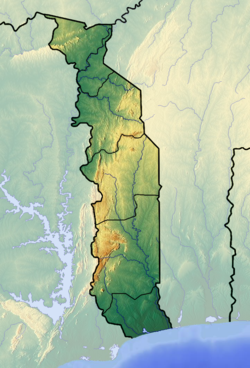Koutammakou
| UNESCO World Heritage Site | |
|---|---|
 | |
| Official name | Koutammakou, the Land of the Batammariba |
| Location | Kara Region, Togo |
| Criteria | Cultural: (vi), (v) |
| Reference | 1140 |
| Inscription | 2004 (28th Session) |
| Area | 50,000 ha (120,000 acres) |
| Coordinates | 10°4′N 1°8′E / 10.067°N 1.133°E |
Koutammakou, the Land of the Batammariba is a cultural landscape designated in 2004 as a UNESCO World Heritage Site in northern Togo.[1] The area features traditional mud tower-houses which remain the preferred style of living. The traditional mud houses are known as a national symbol of Togo. Many of the mud houses have two floors and some of them have a flat roof.
In 2008, to complete the inscription of the site to World Heritage, the Department of Intangible Cultural Heritage (ICH) of UNESCO, headed by Rieks Smeets, set up the « Safeguarding of the Cultural Intangible Heritage of Batammariba », from the 2003 Convention. The goal was to promote sustainability in Intergenerational transmission and preservation of skills and knowledge in all the essential areas of their culture, such as : manufacture of everyday and ceremonial objects, traditional healing and useful plants, takyentas construction, dance, music, archery, oral traditions, promotion of tourism respecting local traditions, mapping sacred areas, accumulation of data on the intangible cultural heritage and creation of access to it, recordings, films and photos…. Overall, teaching the ditammari, language of Batammariba in primary schools and education of youth in the intangible cultural heritage (distribution of texbooks). This program was coordinated by the Ministry of Culture and the Ministry of Primary Education of Togo and by Dominique Sewane, whose groundwork was her research and publications on the Batammaribas’ ceremonial life.[citation needed]
Bibliography
- Philippe et Marie Huet, Koutammakou : portraits en pays somba, Nord Bénin, Hesse, Saint-Claude-de-Diray, 2012, 155 p. (ISBN 978-2-35706-021-0)
- Albert-Marie Maurice, Atakora : Otiau, Otammari, Osari, peuples du Nord-Bénin (1950), Académie des Sciences d’Outre-Mer, Paris, 1986, 481 p. (ISBN 2-900098-11-4)
- Paul Mercier, Tradition, changement, histoire. Les “Somba” du Dahomey septentrional, Anthropos, Paris, 1968, 538 p. (texte remanié d'une thèse)
- Suzanne Preston-Blier, The Anatomy of Architecture – Ontology and metaphor in Batammaliba architectural expression, Cambridge University Press, Cambridge, 1987, 314 p. (ISBN 0-226-05861-1)
- Jean Pierre Vallat (dir.), Le Togo : lieux de mémoire et sites de conscience, L’Harmattan, Paris, 2013, 204 p. + pl. (ISBN 978-2-336-29117-8)
References
- ^ Dominique Sewane, ′Ceux qui malaxent la peau fine de la terre′. Les Batammariba. Anthropologie de l'habiter, 40th Session of Unesco Heritage – Istanbul: THE ETHIC VALUES OF KOUTAMMAKOU, Courrier des Afriques

